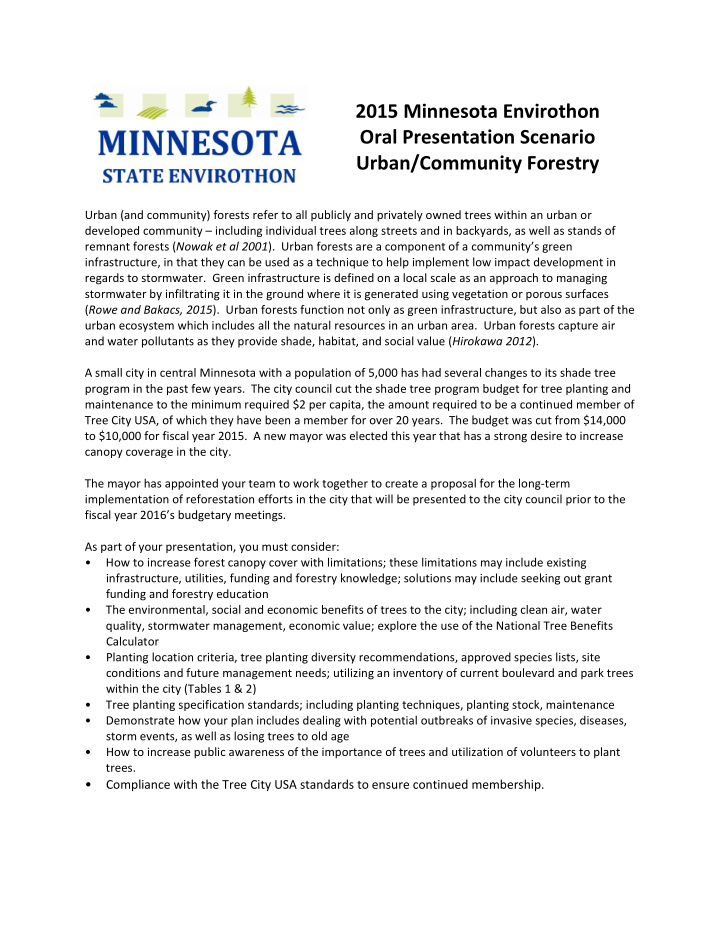



2015 Minnesota Envirothon Oral Presentation Scenario Urban/Community Forestry Urban (and community) forests refer to all publicly and privately owned trees within an urban or developed community – including individual trees along streets and in backyards, as well as stands of remnant forests ( Nowak et al 2001 ). Urban forests are a component of a community’s green infrastructure, in that they can be used as a technique to help implement low impact development in regards to stormwater. Green infrastructure is defined on a local scale as an approach to managing stormwater by infiltrating it in the ground where it is generated using vegetation or porous surfaces ( Rowe and Bakacs, 2015 ). Urban forests function not only as green infrastructure, but also as part of the urban ecosystem which includes all the natural resources in an urban area. Urban forests capture air and water pollutants as they provide shade, habitat, and social value ( Hirokawa 2012 ). A small city in central Minnesota with a population of 5,000 has had several changes to its shade tree program in the past few years. The city council cut the shade tree program budget for tree planting and maintenance to the minimum required $2 per capita, the amount required to be a continued member of Tree City USA, of which they have been a member for over 20 years. The budget was cut from $14,000 to $10,000 for fiscal year 2015. A new mayor was elected this year that has a strong desire to increase canopy coverage in the city. The mayor has appointed your team to work together to create a proposal for the long ‐ term implementation of reforestation efforts in the city that will be presented to the city council prior to the fiscal year 2016’s budgetary meetings. As part of your presentation, you must consider: • How to increase forest canopy cover with limitations; these limitations may include existing infrastructure, utilities, funding and forestry knowledge; solutions may include seeking out grant funding and forestry education • The environmental, social and economic benefits of trees to the city; including clean air, water quality, stormwater management, economic value; explore the use of the National Tree Benefits Calculator • Planting location criteria, tree planting diversity recommendations, approved species lists, site conditions and future management needs; utilizing an inventory of current boulevard and park trees within the city (Tables 1 & 2) • Tree planting specification standards; including planting techniques, planting stock, maintenance • Demonstrate how your plan includes dealing with potential outbreaks of invasive species, diseases, storm events, as well as losing trees to old age • How to increase public awareness of the importance of trees and utilization of volunteers to plant trees. • Compliance with the Tree City USA standards to ensure continued membership.
Table 1. Boulevard Tree Species Breakdown Species Tree % of Species Inventory Total Silver Maple 594 29.7 Sugar Maple 236 11.8 Red Maple 239 11.9 Basswood 218 10.9 Green Ash 202 10.1 Hackberry 148 7.4 Paper Birch 142 7.1 Bur Oak 90 4.5 Colorado Blue Spruce 51 2.5 Red Oak 44 2.2 Black Walnut 21 1.0 White Pine 15 0.7 Black Hills Spruce 2 0.1 Total 2002 100 Table 2. Park Tree Species Breakdown Species # of Trees % per Species Hackberry 36 13.4 Green Ash 35 13.1 Black Hills Spruce 34 12.7 Bur Oak 29 10.8 Basswood 26 9.7 Red Oak 22 8.2 Crabapple 17 6.3 Japanese Tree Lilac 14 5.2 Paper Birch 14 5.2 Red Maple 12 4.5 Lilac 11 4.1 Red Pine 10 3.7 White Pine 8 3.0 Total 268 100
References Tree Inspector’s Field Manual, MN Department of Agriculture National Tree Benefits Calculator: treebenefits.com/calculator/ MN DNR Community Forestry: http://www.dnr.state.mn.us/forestry/urban/index.html Arbor Day Foundation: www.arborday.org US Forest Service Northeastern Area Urban & Community Forestry: http://www.na.fs.fed.us/urban/ American Rivers Report: The Value of Green Infrastructure: http://www.americanrivers.org/newsroom/resources/the-value-of-green-infrastructure/ U of MN Integrated Pest Management of Midwest Landscapes: http://www.entomology.umn.edu/cues/ipmbook.htm Urban Forestry: Planning and Managing Urban Greenspaces, 2 nd Edition – Dr. Robert W. Miller. Prentice-Hall, Inc., Upper Saddle River, New Jersey. 1997. 404 pp. Shading Our Cities: A Resource Guide for Urban and Community Forests – Gary Moll and Sara Ebenreck. Island Press. 1989. 349 pp. Common Insect Pests of Trees in the Great Plains: http://nac.unl.edu/publications/insects.htm Diseases of Trees and Shrubs, 2 nd Edition – Dr. Wayne A. Sinclair and Dr. Howard Lyon. Comstock Publishing Associates. 2005. 608 pp. My Minnesota Woods – Urban Natural Resources: http://www.myminnesotawoods.umn.edu/category/urban-natural-resources/
Recommend
More recommend